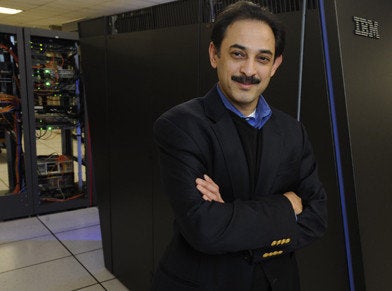
Manish Parashar
Professor of electrical and computer engineering
Rutgers University
For years, universities have worked with businesses to produce joint research and educational programs. But these days there’s a new imperative: we must create collaborations aimed at producing economic development and jobs. At Rutgers, we see these sorts of public-private partnerships not only as a tremendous opportunity for our students and faculty, but as critical resource for New Jersey.
Rutgers announced just such and effort today at a small celebration on the university’s Busch Campus in Piscataway. We’re working with IBM to create a new high-performance computing center, Rutgers Discovery Informatics Institute (RDI2), focused on the application of “Big Data” analytics in life sciences, finance, and other industries. The goal is to improve the economic competitiveness of New Jersey’s public and private research institutions.
The centerpiece is a IBM Blue Gene®/P supercomputer that we’ve named “Excalibur,” playing off our sports mascot, the Scarlet Knight. In addition to gaining access to the hardware and an impressive array of software and technical support, Rutgers faculty members and graduate students and technical people from New Jersey companies will be able to work with IBM scientists and engineers on joint research projects.
When IBM approached us last year to propose a high performance computing center, we immediately started thinking about how Rutgers and the private sector researchers in New Jersey could have on the world’s most difficult challenges. We began reaching out to some of the dozens of pharmaceutical and financial services firms in our area. They reacted positively. Until today, there had not been an academic supercomputing resource available to commercial partners in New Jersey.
IBM’s Steve Mills just last week had a post on A Smarter Planet talking about data as the next great natural resource. Steve’s observation is spot on. Putting “Big Data” to work will be the central role of our new center. And we anticipate future expansion of the center will lead to the university having one of the nation’s most powerful academic supercomputers.
It’s clear that the ability to conduct computations and data analysis on very large scales, leveraging the power of high-end resources, has become increasingly essential to research and development. The Institute will foster and nurture partnerships with industry around their large compute and large data needs. We’ll be looking at fields such as cancer and genetic research, medical imaging and informatics, advanced manufacturing, environmental and climate research, and materials science. All of these areas are critical to our students’ education and our university’s future ability to compete for research dollars.
My own research has focused applying parallel and distributed computing to address grand challenges in science and engineering. Last year we partnered with IBM and the University of Texas at Austin to demonstrate how an elastic computing cloud composed of multiple geographically distributed BlueGene/P systems can be used to enable ensemble oil reservoir modeling applications. This project won first place at the IEEE International SCALE 2011 Challenge.
There is a strong correlation between having this level of sophisticated research infrastructure and research productivity. Science and engineering are changing dramatically–becoming very computational and data-intensive. Large-scale computing is now critical for scientists and engineers to address research grand challenges in diverse fields from biochemistry and genomics to material sciences and climate modeling.
So RDI2 is a win for the university and a win for New Jersey.
ABOUT THE AUTHOR: Manish Parashar, professor of electrical and computer engineering at Rutgers, is the university’s lead faculty member on the project and will direct the new institute. He led a team that won the 4th IEEE International Scalable Computing Challenge (SCALE 2011), “A Scalable Ensemble-based Oil-Reservoir Simulations using Blue Gene/P-as-a-Service,” in May 2011. Parashar is director of Rutgers’ Center for Cloud and Autonomic Computing and the Applied Software Systems Laboratory, and associate director of the Center for Information Assurance.